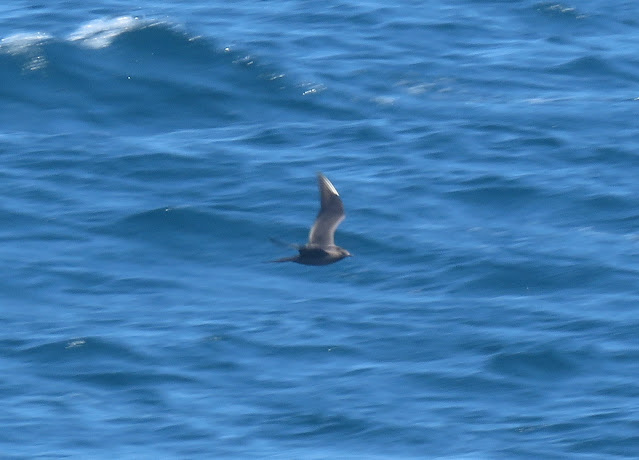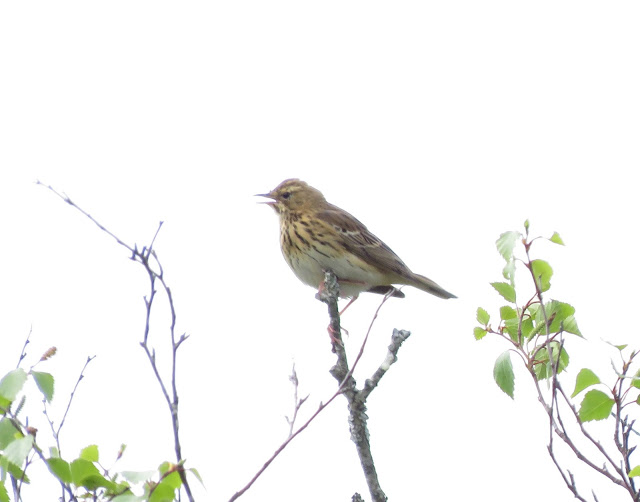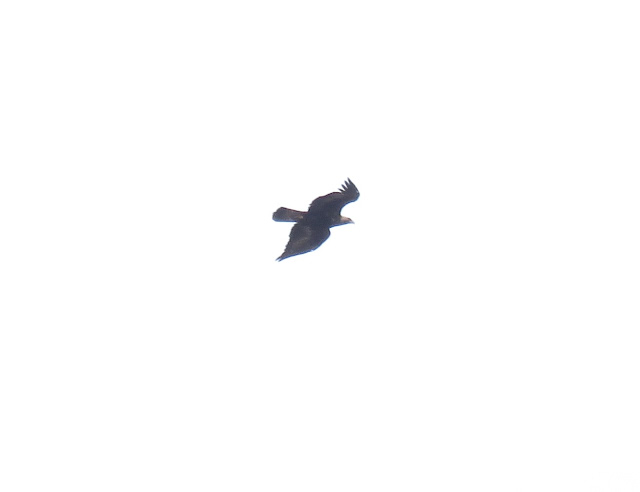Saturday, May 28, 2022
A second visit to the valley of the bone caves brought more mountain avens in flower - although plenty of buds promised an even better show to come.
Greger was trying out the camera in his new smartphone.
Going back down, we were stopped in our tracks by the rapid bubbling call of a female cuckoo. We never located it, so perhaps it had been flying over. Two male cuckoos had been calling for much of our walk and one was seen flying above the bone caves. The "puddle" in the picture below was a dry hole full of tumbled boulders and sand on our last visit; but we've had an enormous amount of rain since then and a spring somewhere below has come to life and sent water surging down to join the stream to the left. Behind me, that stream dries up; so it's this spring and several others below it that supply the rushing river and waterfall seen lower down the valley.
Further on we spotted a dipper.
A male and a female grey wagtail were busy fly-catching over the water, and swallows and sand martins were swooping. Four ravens were mooching about, and we saw a meadow pipit and a wheatear. The rain kept off for our walk but it was still pretty windy and also fairly cold.
Friday, May 20, 2022
I was reading about the last near-glacial period of about 12,000 years ago when my imagination was caught by its name - the Younger Dryas. It comes from the wildflower Dryas octopetala, or mountain avens as it's commonly called. This is because parts of the flower have been found in fossilised remains from both this and the Older Dryas (wildflowerfinder.org.uk), although another source (which I've forgotten) put it in a slightly different way - that this is one of the first plants to recolonise an area once the ice sheet has retreated. That's a lovely idea. At any rate, it's a plant that loves the cold, and it's almost always found in areas of limestone. I'd read online that the path up to the bone caves was a good place to look for it, so today we walked that path - half wishing we were continuing on up to the summit of Breabag once again.
The bone caves are spooky and worth a look, although I guess some children are disappointed that there are no bones to be seen there now. Come to that, I'm disappointed there are no bones to be seen there now!
We carried on along the path that traversed the steep slopes....
.....and at last found what we were searching for. I noticed the dark green, crinkly leaves first, and then found some buds. There were only a few fully opened flowers, so I'll have to come back in a week or so.
We rested at the bottom of the cliff and "cuckoo" rang out several times - with such a hollow tone that I thought the bird was actually inside one of the caves. But there it was on the skyline, above the caves, with a meadow pipit visible now and then protesting against its presence.
On the way back down, Greger pointed out some ghostly palmate newts in a very dark and murky pool - my first newts of the year.
We failed to see ring ouzels or dippers on our walk but did record a singing wheatear, a male stonechat, two ravens, a buzzard, and a willow warbler.
Thursday, May 19, 2022
I was about to turn on the shower when a loud, repeated tapping came from above; and I could just see a large bill at the bottom of the skylight. It was quite a comical sight so I grabbed a towel, climbed out of the bath, and fetched my camera. By the time I'd gone back into the bathroom however, the gull had stepped onto the glass itself.
It had stopped tapping but was casting quizzical looks downwards, so I flapped my arms and shouted until it flew away. I had no wish to find myself sharing a small bathroom with a large gull and a shower of broken glass!
Greger's only just shown me the pics he took on his smart phone during the pelagic. Coming back up with his morning coffee, he was amused to find me on my own on deck with a threatening cloud above.
Good job we had brighter weather for the homeward trip!
Wednesday, May 18, 2022
It was the wrong day really for a pelagic but Greger was game so we walked down to the harbour in the rain, trusting that the weather forecast for a better afternoon would prove correct. Once again the trip out was fairly quiet (I'm not saying there was nothing to be seen, just that I didn't manage to see it!) apart from my first terns of the year. Greger was down buying coffee so he missed these. They were a long way out on a fairly exciting sea, so I can't say whether they were common or Arctic; but it was still a nice sighting.
On the way back we both had good views of a skua just ahead of us and converging with the ferry. It was difficult to hold the camera steady and I couldn't get any better shots than these; it was only as I clicked off the last one that I was aware of a second bird closer in.
Well, it's clearly a second skua - and I think a pale-form Arctic whereas the top bird is probably a dark-form (tail too short, I think, for long-tailed). I'm not happy with the word "phase" which means a temporary state, a stage which will be passed through; whereas, as far as I know anyway, these birds are one or the other for life.
We saw a few fulmars, no more than three or four gannets, and two kittiwakes. On a more cheerful note there seemed to be loads of puffins whizzing about - mostly in pairs. Although there was a little rain on the way out, the voyage back was under mostly blue skies and sunshine. But there was a lot of spray on the way out - which had left, we belatedly realised, a rime of salt on the rails and on the backs of the seats. This had transferred to our dark coats as conspicuous white markings - we'll have to get some oilskins for the next pelagic!
Tuesday, May 17, 2022
Turnstone and dunlin, foraging in the tidewrack at Badentarbat, were photobombed by a pied wagtail.
A solitary sanderling was also present - showing just a few concessions to the idea of summer plumage.
A dunlin came up onto the grass where I sat in my car and set about drilling the ground - at one point extracting what looked like a leatherjacket.
A herring gull was hunting on the falling tide, sailing a couple of metres from the shore and then plunging its head and neck in and coming up with fish or crabs which it had spotted gliding or scuttling across the sandy bottom.
And that, folks, is why the gulls don't need your fish-and-chips. They're perfectly capable of finding their own food - they just like to try it on.
Several ringed plovers, a couple of oystercatchers, and a common sandpiper were also present; while two whimbrels flew over calling and landed much further down the beach. Seven black guillemots were far out on the water, and a Bonxie cruised over.
Driving back across the headland I heard a cuckoo and spotted it up the slope, in a fairly lonesome pine.
Rotten pic, but it's only the second cuckoo I've managed to see this year. Back at the junction lay-by, I looked down across the sheep paddock to the river where a greenshank was feeding.
A last stop on the drive out was to look at the little pool where I first noticed bogbean flowers.
It's an odd little flower; there never seems to be a real "carpet" of blooms because the flowers don't come out together; there seem to always be seeding flowers and budding flowers as well as fully-out flowers on the stem at the same time - and the plants don't all bloom together either. So it remains a quiet wildflower, almost insignificant; if you don't know about it, you might not notice it - which was the case with me, until the chipper call of a snipe at the edge of the pool attracted my attention. Sad to relate, there was no chipper call to be heard today. Apart from a lone skylark, there was a silence on the moors.
Sunday, May 15, 2022
Two singing tree pipits were seen on a walk up the quarry road....
.....and a grey wagtail was back on its territory near the river. Willow warblers and one blackcap were singing, and a cuckoo was heard in the distance. It was great to be walking in thin summer trousers and T-shirt - for the first time this year!
Saturday, May 14, 2022
At least two sedge warblers were singing in the village near the river this morning.
A walk up the quarry road brought two singing tree pipits; while a golden eagle, first spotted over a far ridge, flew over the quarry road and was lost behind the trees.
Yesterday: It was set to rain all day here, with drier weather over east; so when Greger suggested a trip to Inverness I readily agreed - not without ulterior motives of a birdy kind. It was a relatively successful shopping trip as I actually bought a couple of clothing items, and we had a nice lunch in Girvans. A walk by the river brought what I'd hoped for but hadn't really expected, given how slow the spring has been so far.
Swifts! We saw three together but there were probably more. They swooped over the river with swallows and martins, but also went up really high; they were the icing on the cake of an enjoyable visit.
I was going to say that Inverness is as far as I've been in the last two and a half years - but we did have a trip down to the Cairngorms last month. And I've had the pelagics of course. These are my own mini-cruises - although there's nothing relaxing about them, filled as they are with frantic attempts to spot, identify, and photograph fast-moving birds from a fairly fast-moving ferry. Can't wait for the next one!
The previous day, I'd seen my first sanderlings of the year at Achnahaird, with probably c100 dunlin and smaller numbers of ringed plover.
A restless whimbrel was twice seen flying at a distance, and over at Badentarbat, in a ferocious wind with spatters of rain, a beautiful white-winger flew past - while I was eating my sandwiches, naturally. It looked especially gorgeous in the grim weather. Several Bonxies were seen. There were still no lapwings on the machair - but there were loads of hoodies, which seemed to make the waders uneasy when they flew over them and landed nearby.
Sunday, May 08, 2022
It wasn't my first dunlin of the year (25+ at Achnahaird a few days ago) but it was my first here in the village (on the river spit).
A redwing seen yesterday was possibly a late migrant, but apparently some do breed in the UK.
I've spotted a cuckoo and a swallow at last but chiffchaff, though heard in a couple of places, remains unseen. Wood warbler and grasshopper warbler have been sought but not found. More to the point, will I ever be able to go out without my woolly hat and thermal underwear? They say that spring takes two weeks to travel from southern England to the north of Scotland. No it doesn't. It takes a lifetime.


.jpeg)

.jpeg)




















.jpeg)

.jpeg)




